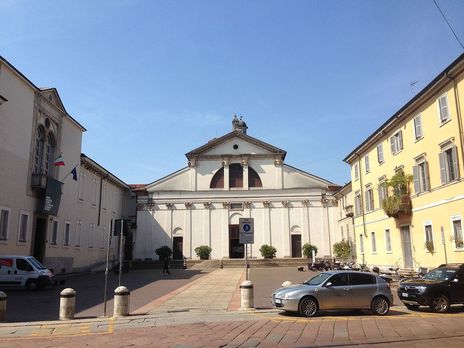

Although this church, thanks to its pale, uninspired facade, seems rather unappealing, if not even unnoticeable, it happens to be an important place of worship for the Milanese religious community and possesses an opulent interior that is worth a visit.
The church is dedicated to St Victor the Moor, a 3rd century soldier from Mauretania, or present day Morocco, who served in the ancient Roman army and after secretly converting to Christianity began destroying pagan altars. "Al Corpo" means at or of the body. When Victor was captured, he refused to renounce his faith, even after a series of unthinkable tortures including molten lead being poured on his wounds. Legend has it that his body was never buried, but was soon found by Maternus, the Bishop of Milan, some time around the year 303. It was St Ambrose, Milan's most famous bishop and patron, who promoted Victor's cult in the 4th century. The cult grew so rapidly that within the next hundred years, besides the Church of St Victor at the Body, six other churches were erected in his honor.
The most fascinating thing about the construction of the church is that it stands on the spot of an ancient mausoleum that was built for Emperor Maximian, the emperor that had Victor executed, thus symbolizing Christianity's triumph over pagan religions. The original church was built in the 4th century over the foundations of the octagonal mausoleum, which can still be visited today, although Maximian himself was never buried there. Emperors Valentinian II and Gratian, however, were.
The church that we see today was erected in the middle of the 16th century by architects Vincenzo Seregni and Galeazzo Alessi. Its interior has a three-nave layout with a clear division of the transept and apse. The central nave's ceiling is covered with coffers painted with images of all the saints lying in the church. Elegantly frescoed pilasters separate the side naves, which contain six chapels each. A high bright dome rises over the transept on four mighty pillars and shows the Four Evangelists, as illustrated by Daniele Crespi.
Even though we will not find any world famous pictorial masterpieces inside, we will be impressed by the rich, intricate and highly imaginative stuccowork decorating the entire shrine. But for lovers of Italian painting there are a couple of works that are worth a glance: the fresco of St Frances of Rome in the third chapel on the right and the three canvases depicting the Stories of St Gregory in the apse of the right transept by Camillo Procaccini. There is also the Stories of St Benedict, in the apse of the left transept, painted by Ambrogio Figino.
It was the Olivetans, a monastic order founded in 1313 by Bernardo Tolomei of Siena, that acquired the original church in 1507 and had it rebuilt. Formally known as the Order of Our Lady of Mount Olivet, in honor of the place from which Jesus ascended to heaven, the original members lived as hermits in the Accona desert in Tuscany. They later built a monastery near Asciano and in 1344 adopted the Rule of St Benedict, which facilitated their recognition as a Catholic order. Their following spread widely and today they have monasteries, besides Italy, in the USA, England, France, Israel, Brazil and South Korea. Their monastery at the Church of St Victor of the Body was completely destroyed during the American bombing and was rebuilt with a different design, a practice that was not very usual.
Today the church is the headquarters of the non-profit Ambrosian Bell-ringer Federation, which is dedicated to the protection and restoration of bells, as well as to the tutelage of the artistic patrimony related to them.